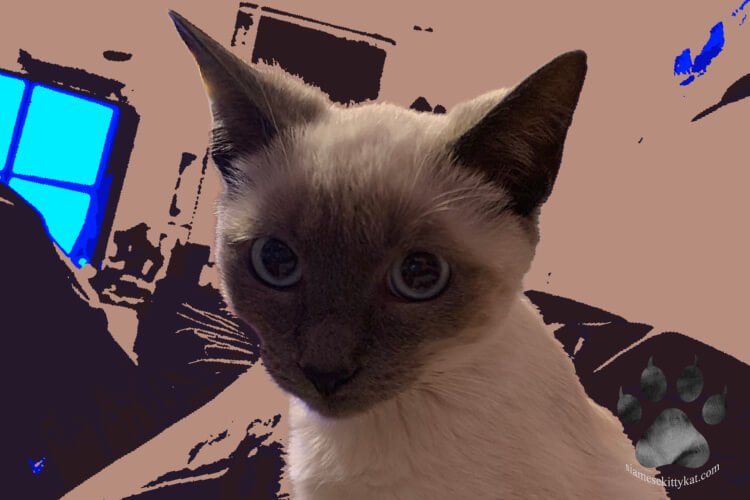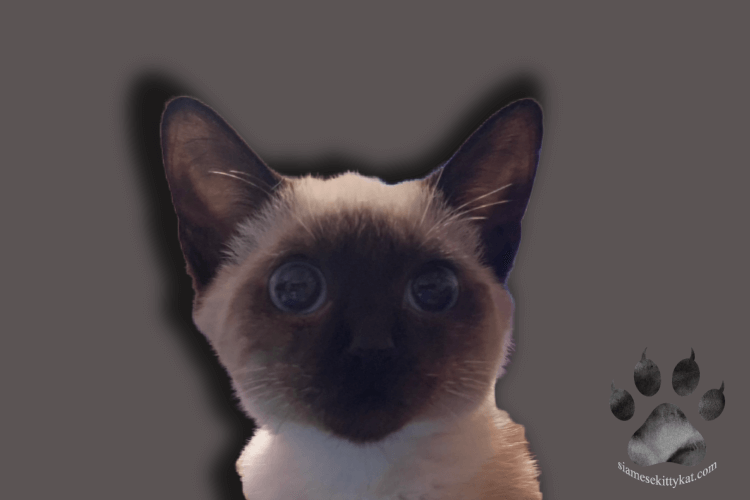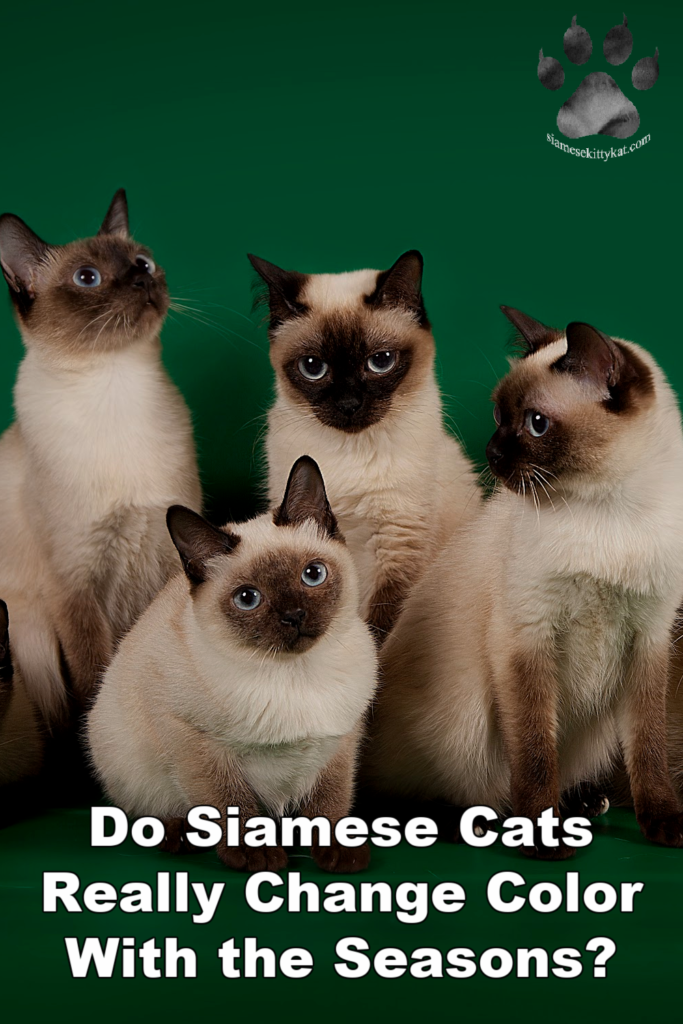If I were to tell you that Siamese cats are albinos, would you believe me? Well, I can tell you that Siamese kitties are in fact albinos – temperature-sensitive ones at that!
Siamese cats have this unique gene that causes them to be born all white. Once they reach a certain temperature after birth, their fur begins to change color.
The drastic changes within your Siamese kitties’ fur will only happen when their color points begin to develop. However, as the seasons change you will see a slight change in the color of their fur.
In the summer, their fur will become lighter due to the heat and sun, and in the winter it’ll become darker as the cold temperatures roll in. So, yes, the changing seasons do affect the fur of a Siamese.
Why do Siamese cats change color?
The reason a Siamese’s coat changes color all depends on the temperature of their skin. The colder it is, the darker it will go.
A Siamese kitten spends 9 weeks developing in their mother’s toasty womb – which averages to about 101 degrees F. Due to the heat of the womb, the kitten will stay completely white.
After a week of resembling Frosty The Snowman, the Siamese will slowly begin to change color. Much like us humans (minus the tail) Siamese cats feel the coldest on their noses, paws, ears, and tail.
When these places, known as ‘points’ fall below 98 degrees F, their fur will begin to develop darker patches. The strength of the color depends on temperature, however, the color itself is all down to the kitties’ genetics.
For example, if you were to shave a part of your Siamese during winter (maybe for surgery) it’s more than likely that the patch will grow back much darker than the rest of the hair due to their skin being colder.
This specific genetic material is called the “Himalayan Gene” and affects the Siamese’s epidermis cells. It’s a super unique set of coded genes and it’s incredibly interesting, to say the least!
What color do Siamese cats turn?

Surprisingly enough, Siamese cats come in many different colors. There are, however, only 4 primary variations: Chocolate Point, Blue Point, Seal Point, and Lilac Point.
Recently, Tortie Point, Flame Point, Cinnamon Point, Lync Point, and many more have been appearing. These are often referred to as ColorPoint Shorthairs.
Chocolate Point
Chocolate Point kitties usually have cream or ivory fur, either with or without shading along their back. Until they reach two or three years of age, this color usually stays quite pale.
Their points usually resemble chocolate milk, seen on their ears, face, paws, and tail. The paw pads on a Chocolate Point Siamese are pink, as well as their nose leather.
Seal Point
Seal Point Siamese and Chocolate Point Siamese usually get confused due to their similar color points. However, a Seal Point cat develops their color a lot quicker than a Chocolate.
Their body fur can either be fawn or cream in color, with lighter fur on their chest and belly due to the warmth of their skin. Seal Points vary the most in color, with their backs turning a caramel-beige and even dark brown later down the line.
Their color points – face, ears, tail, and paws – are usually a dark brown (resembling that of a seal). The paw pads and nose leather of a Seal Point are either deep brown or black.
Blue Point
A Blue Point Siamese will have a body that is usually blue-white in color. They sometimes have shading along their backs and other times do not. Just like their Seal Point brothers and sisters, Blue Point kitties also tend to darken with age.
Their color points can vary, either being cold, slate-gray, or silvery-blue. The paw pads and nose leather of a Blue Point are gray.
Lilac Point
Lilac Points have a very pale cream or white fur, making them the lightest of all the original Siamese points. These coats generally stay quite light throughout their entire lives.
The points on a Lilac Point are also very light, being either a pinkish-gray or brown. The paw pads and nose leather of these kitties are usually a lilac pink.
Do Siamese coats change in the sun?
Siamese kitties are very similar to us in the sense that if we spend a lot of time in the sun, our hair will begin to lighten. Siamese cats love a good bask in the sun, and it’s not a surprise if you catch them sprawled out on the windowsill on a sunny day.
The sun actually bleaches the hair, so if you have a Siamese with black fur, it may turn a lighter brown when exposed to a lot of sun. This doesn’t really have anything to do with the gene we mentioned earlier, as that affects the skin and not the hair.
What are the reasons a Siamese’s fur changes color?

Old Age
Just like us humans, it’s not uncommon for a cat’s coat to change as they age. If your Siamese has started life with dark points, you may notice their aging in their fur before you do anywhere else.
Diet Deficiencies
If you have a Siamese with black points, they may begin turning a rusty brown if they experience a deficiency of the tyrosine enzyme. This enzyme is responsible for producing melanin, the pigment that gives the fur its color.
To fix this problem, you need to switch out their diet for food rich in minerals. This will keep your cat healthy and thriving, so check the food you’re currently feeding them.
Keeping your Siamese on a vegetarian diet could be the cause of the loss in tyrosine.
Chicken and fish are rich in these enzymes, so it’s a good idea to add these into their diet.
Health Conditions
If your Siamese is suffering from certain health conditions, you may be able to spot their fur turning a lighter shade. Health conditions that affect their tyrosine and metabolism will cause this.
If your Siamese has begun to turn color without reason (a fully grown adult with no drastic temperatures) then seek help from a vet as soon as possible.
Siamese cats are certainly a unique breed. From their proud and loud voices to their interesting genetic makeup that changes with the weather – these lovable kitties will be sure to paw their way into your heart!
Want to immerse yourself more in the captivating world of Siamese cats? I’ve got all the information you need from their distinct color points to their fun personalities: Siamese Cats: Unique Features and Personality
Get your FREE Siamese Cat 2026 Printable Calendar

